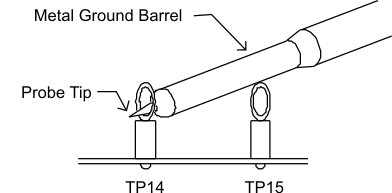SLVU431A January 2011 – December 2021 TPS53219
4.1 Test Equipment
Voltage Source: The input voltage source VIN must be a 0-V to 14-V variable DC source capable of supplying 10 ADC. Connect VIN to J4 as shown in Figure 4-2.
Multimeters:
- V1: VIN at TP7 (VIN) and TP8 (GND)
- V2: VOUT at TP14 (VOUT) and TP15 (GND)
- A1: VIN input current
Output Load: The output load must be an electronic constant resistance mode load capable of 0 ADC to 30 ADC at 1.1 V.
Oscilloscope: A digital or analog oscilloscope can be used to measure the output ripple. The oscilloscope must be set for the following:
- 1-MΩ impedance
- 20-MHz bandwidth
- AC coupling
- 2-µs/division horizontal resolution
- 50-mV/division vertical resolution
 Figure 4-1 Tip and Barrel Measurement for Vout Ripple
Figure 4-1 Tip and Barrel Measurement for Vout RippleFan: Some of the components of this EVM can approach temperatures of 60°C during operation. A small fan capable of 200-400 LFM is recommended to reduce component temperatures while the EVM is operating. The EVM must not be probed if the fan is not running.
Recommended Wire Gauge:
- VIN to J4 (12-V input):
The recommended wire size is 1 × AWG 14 per input connection, with the total length of wire less than four feet (2-foot input, 2-foot return). - J5 to LOAD:
The minimum recommended wire size is 2 × AWG 14, with the total length of wire less than four feet (2-foot output, 2-foot return).